
Crotalus cerastes, known as the sidewinder, horned rattlesnake or sidewinder rattlesnake, is a pit viper species belonging to the genus Crotalus, and is found in the desert regions of the Southwestern United States and northwestern Mexico. Like all other pit vipers, it is venomous. Three subspecies are currently recognized.

The Gaboon viper, also called the Gaboon adder, is a viper species found in the rainforests and savannas of sub-Saharan Africa. Like all other vipers, it is venomous. It is the largest member of the genus Bitis, and has the longest fangs of any venomous snake – up to 2 inches (5 cm) in length – and the highest venom yield of any snake. No subspecies are recognized.

Bitis is a genus of vipers found in Africa and the southern Arabian Peninsula. It includes the largest and the smallest vipers in the world. Members are known for their characteristic threat displays that involve inflating and deflating their bodies while hissing and puffing loudly. The type species for this genus is B. arietans, which is also the most widely distributed viper in Africa. Currently, 18 species are recognized.

Bitis nasicornis is a viper species belonging to the genus Bitis, part of a subfamily known as "puff-adders", found in the forests of West and Central Africa. This large viper is known for its striking coloration and prominent nasal "horns". No subspecies are currently recognized. Its common names include butterfly viper, rhinoceros viper, river jack and many more. Like all other vipers, it is venomous.
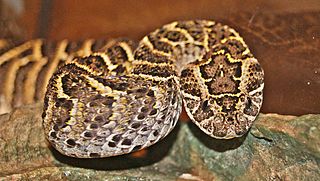
The puff adder is a highly venomous viper species found in savannahs and grasslands from Morocco and western Arabia throughout Africa except for the Sahara and rainforest regions. It is responsible for causing the most snakebite fatalities in Africa owing to various factors, such as its wide distribution, frequent occurrence in highly populated regions, and aggressive disposition. Like all other vipers, it is venomous. Two subspecies are currently recognized, including the nominate subspecies described here.

Cerastes is a genus of small, venomous vipers found in the deserts and semi-deserts of northern North Africa eastward through Arabia and Iran. Three species are currently recognized by ITIS, and an additional recently described species is recognized by the Reptile Database. Common names for members the genus include horned vipers, North African desert vipers, and cerastes vipers.

The berg adder is a venomous viper species endemic to mountainous regions in southern Africa. No subspecies are currently recognized.

The horned adder is a viper species. It is found in the arid region of southwest Africa, in Angola, Botswana, Namibia; South Africa, and Zimbabwe. It is easily distinguished by the presence of a single, large horn-like scale over each eye. No subspecies are currently recognized. Like all other vipers, it is venomous.

The many-horned adder is a viper species. It is found in certain rocky desert areas, mostly along the Atlantic coast of southern Africa, in western South Africa and southwestern Namibia. It has characteristic tufts of "horns" above each eye. Like all other vipers, it is venomous. No subspecies are currently recognized.
The Albany adder is a viper species. It was previously considered a subspecies of Bitis cornuta. Its range is restricted to eastern and southern Cape Province in South Africa. Like all vipers, it is venomous.
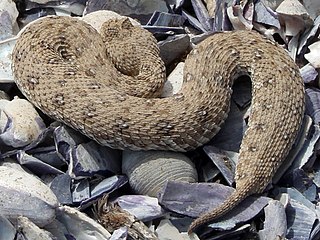
Bitis schneideri is a species of venomous snake in the subfamily Viperinae of the family Viperidae. The species is native to a small coastal region that straddles the border between Namibia and South Africa. B. schneideri is the smallest species in the genus Bitis and possibly the world's smallest viper. There are no subspecies that are currently recognized as being valid.

Bitis inornata is a venomous viper species found only in Cape Province, South Africa. No subspecies are currently recognized.

Bitis parviocula is a venomous viper species found only in Ethiopia. It is large with a broad head and spectacular geometric markings. In 1995, the species was known from only three specimens, but additional information has surfaced since then. Little is known about its natural history or its venom. No subspecies are currently recognized.
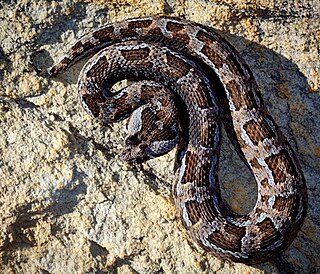
The red adder is a viper species found only in Western Cape Province, South Africa. No subspecies are currently recognised. Like all other vipers, it is venomous.
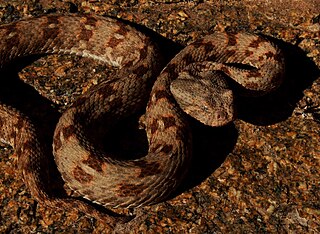
Bitis xeropaga, commonly known as the desert mountain adder or Lüderitz dwarf viper, is a viper species found in southern Namibia and northwestern Cape Province in South Africa. Like all other vipers, it is venomous. No subspecies are currently recognized.

Causus rhombeatus, commonly known as the rhombic night adder, is a viper species endemic to subsaharan Africa. No subspecies are currently recognized. Like all other vipers, it is venomous.
Causus bilineatus is a viper species endemic to south central Africa. No subspecies are currently recognized. Common names include lined night adder, two-lined night adder, and two-striped night adder. Like all other vipers, it is venomous.
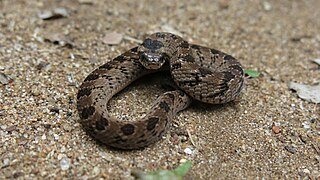
Causus defilippii, commonly known as snouted night adder, is a species of snake in the family Viperidae. The species is endemic to East and Southern Africa. Although its venom is nonlethal to humans, it is still considered medically significant. There are no recognized subspecies.
Causus lichtensteinii is a viper species endemic to western, central, and eastern Africa. There are no subspecies that are recognized as being valid. Like all other vipers, the species is venomous.

The Persian horned viper, known as the Persian horned viper, false horned viper, and by other common names, is a species of vipers endemic to the Middle East and Asia. Like all other vipers, it is venomous.



















